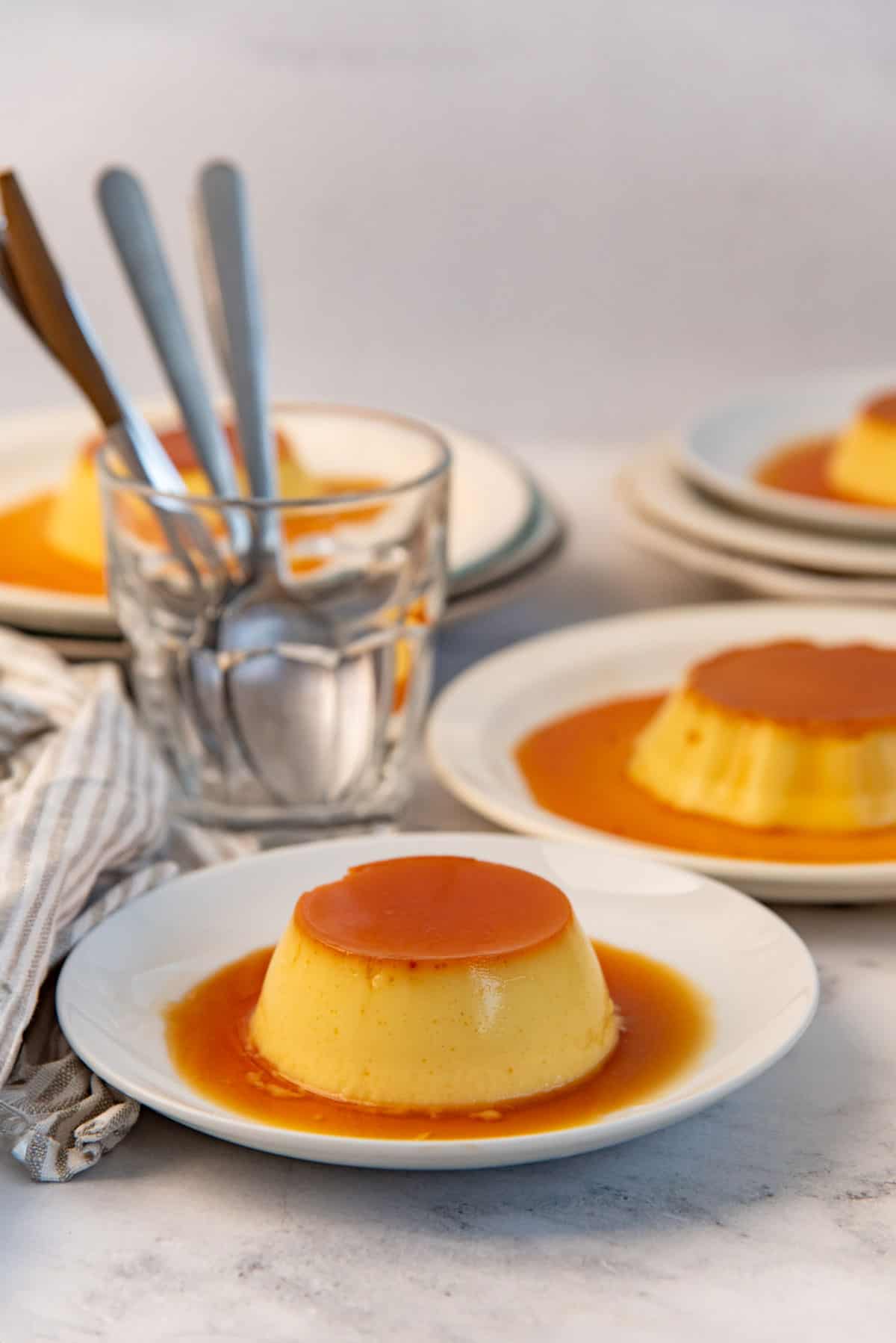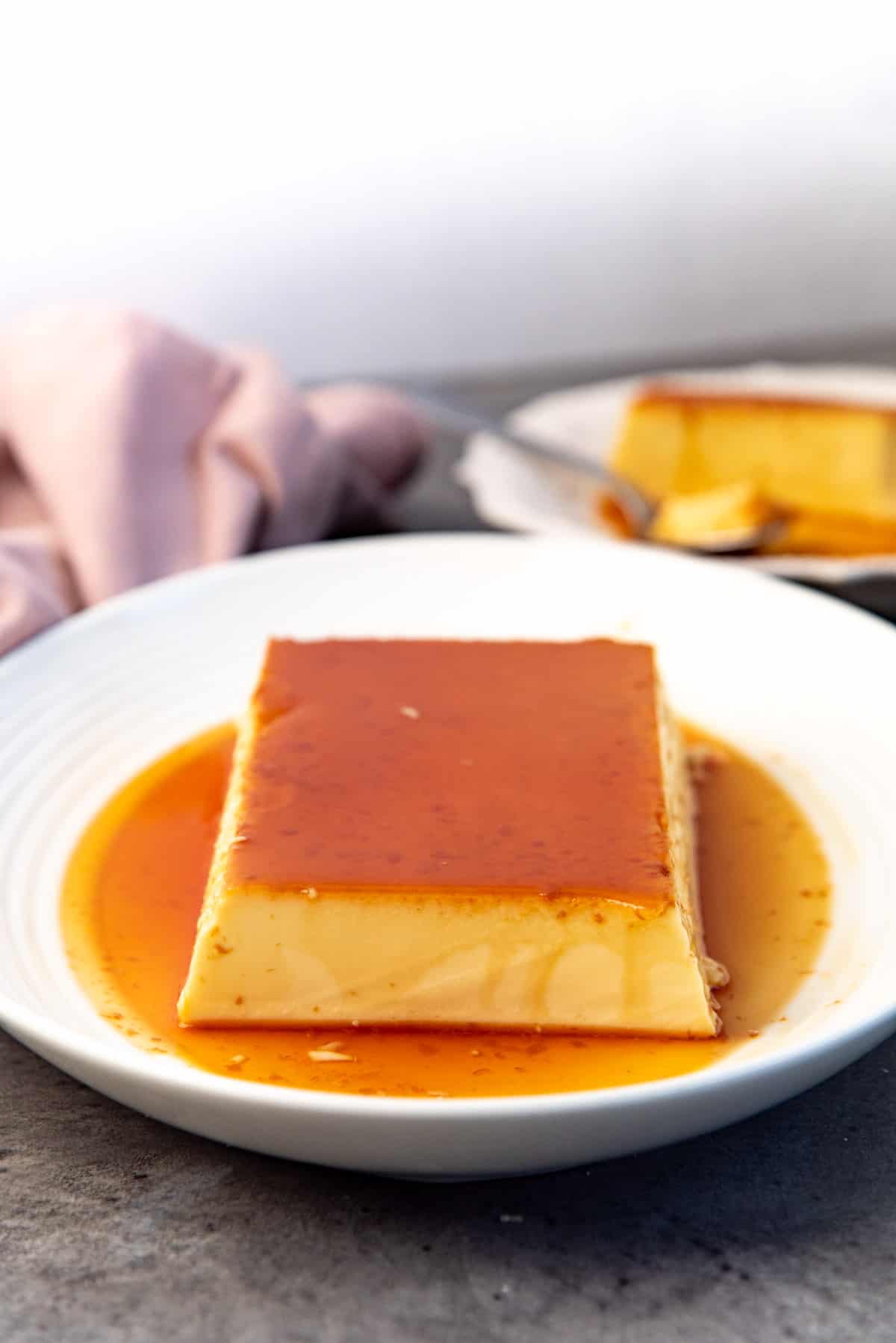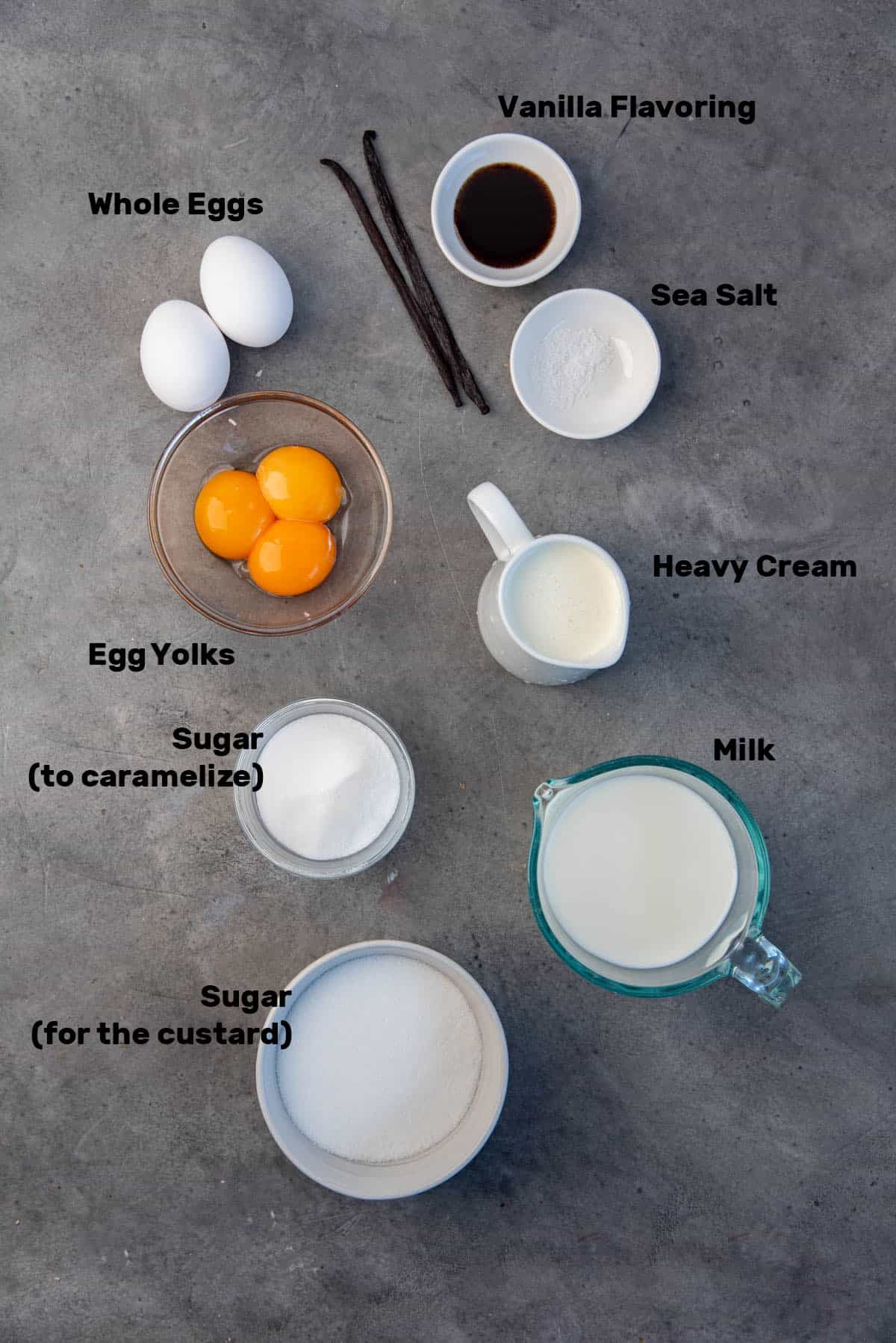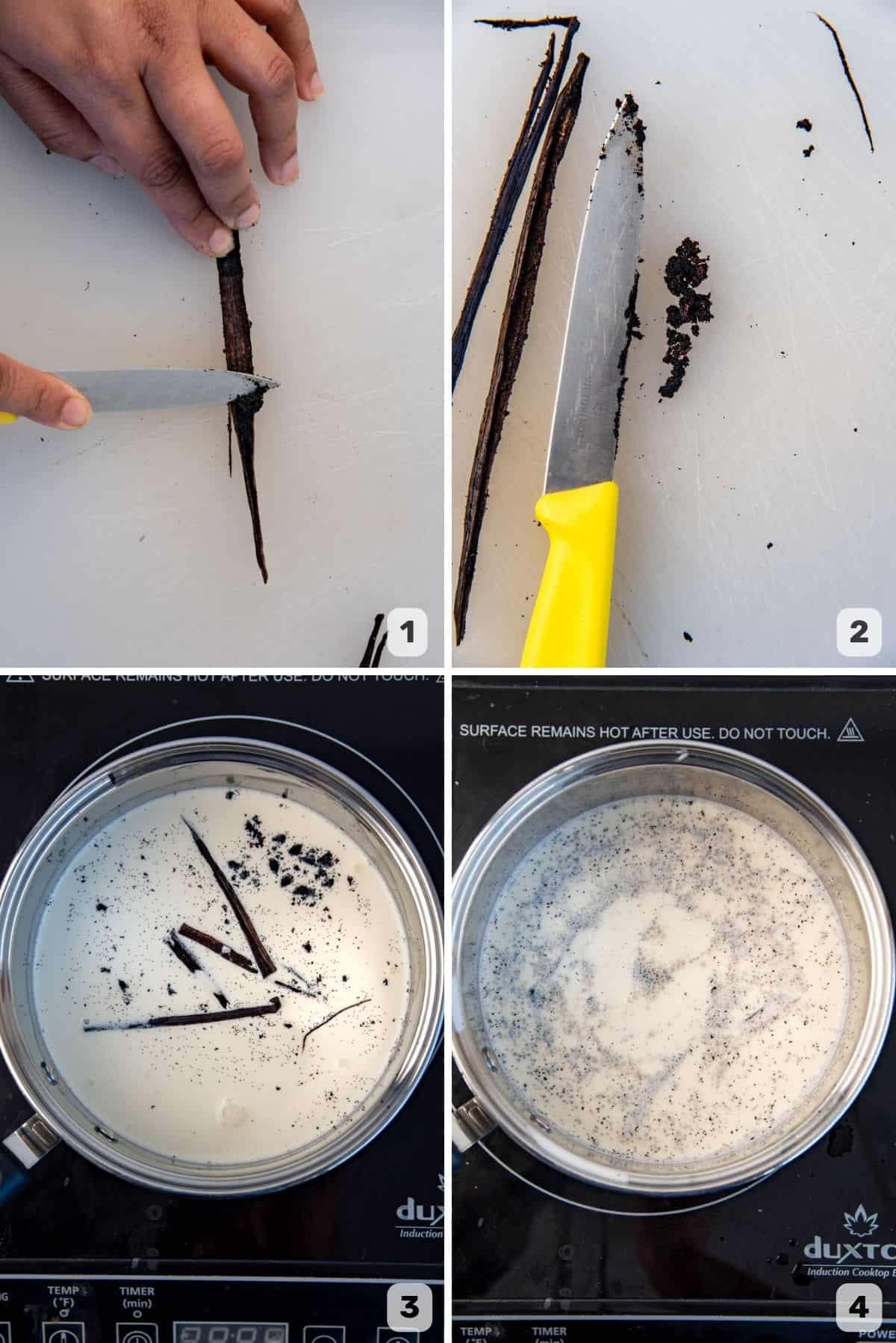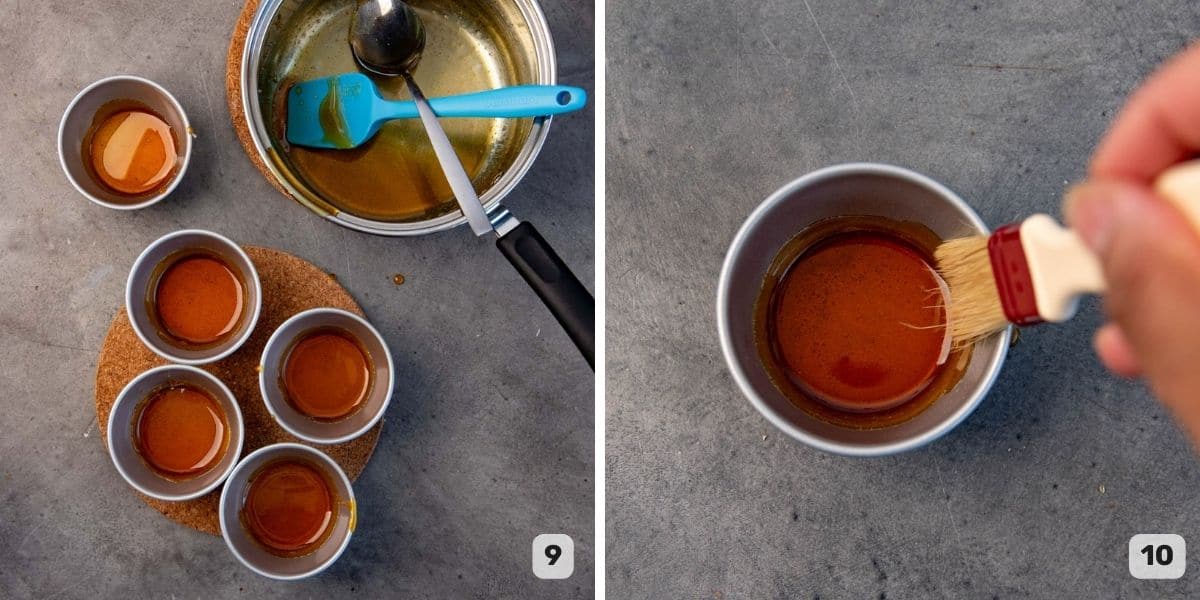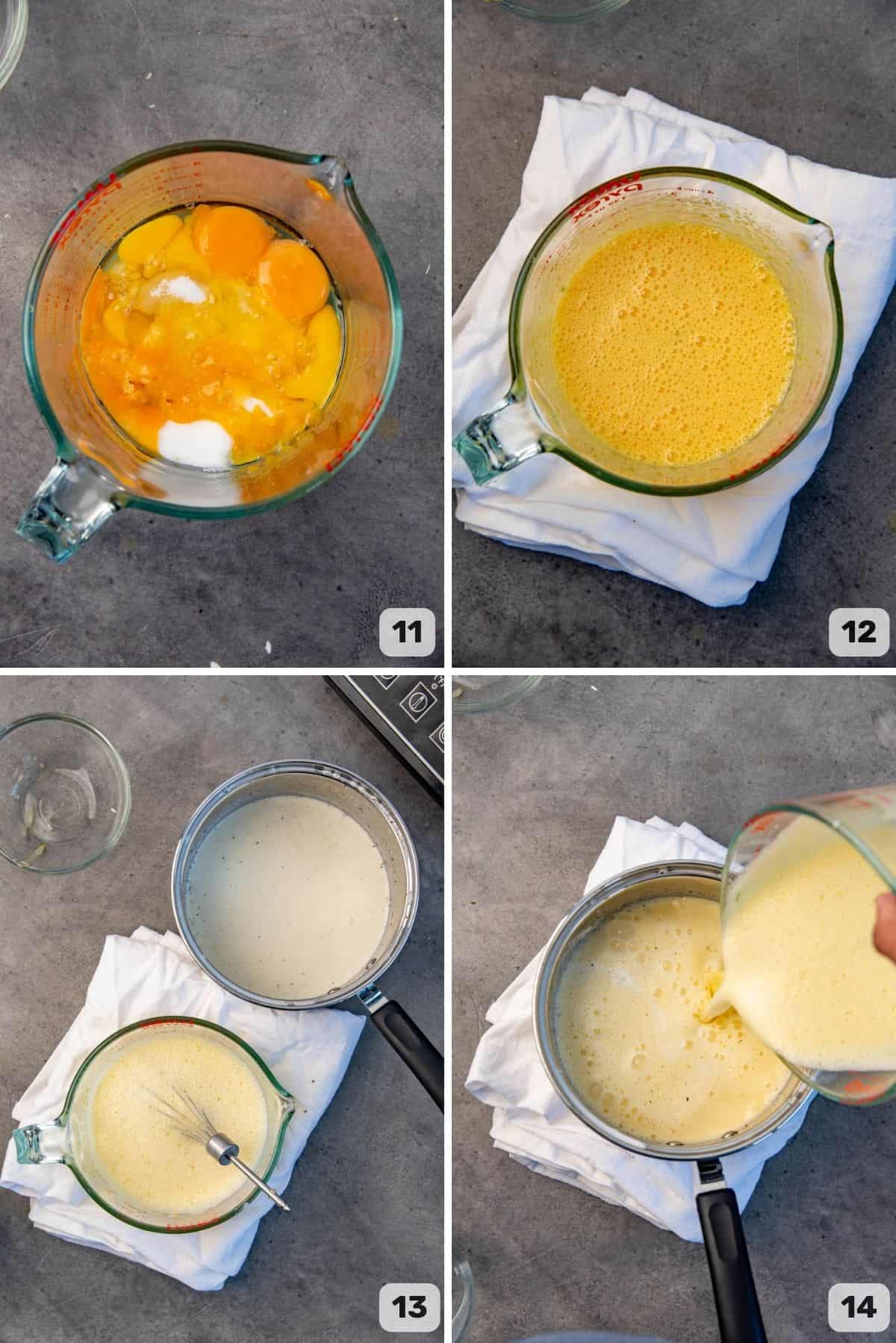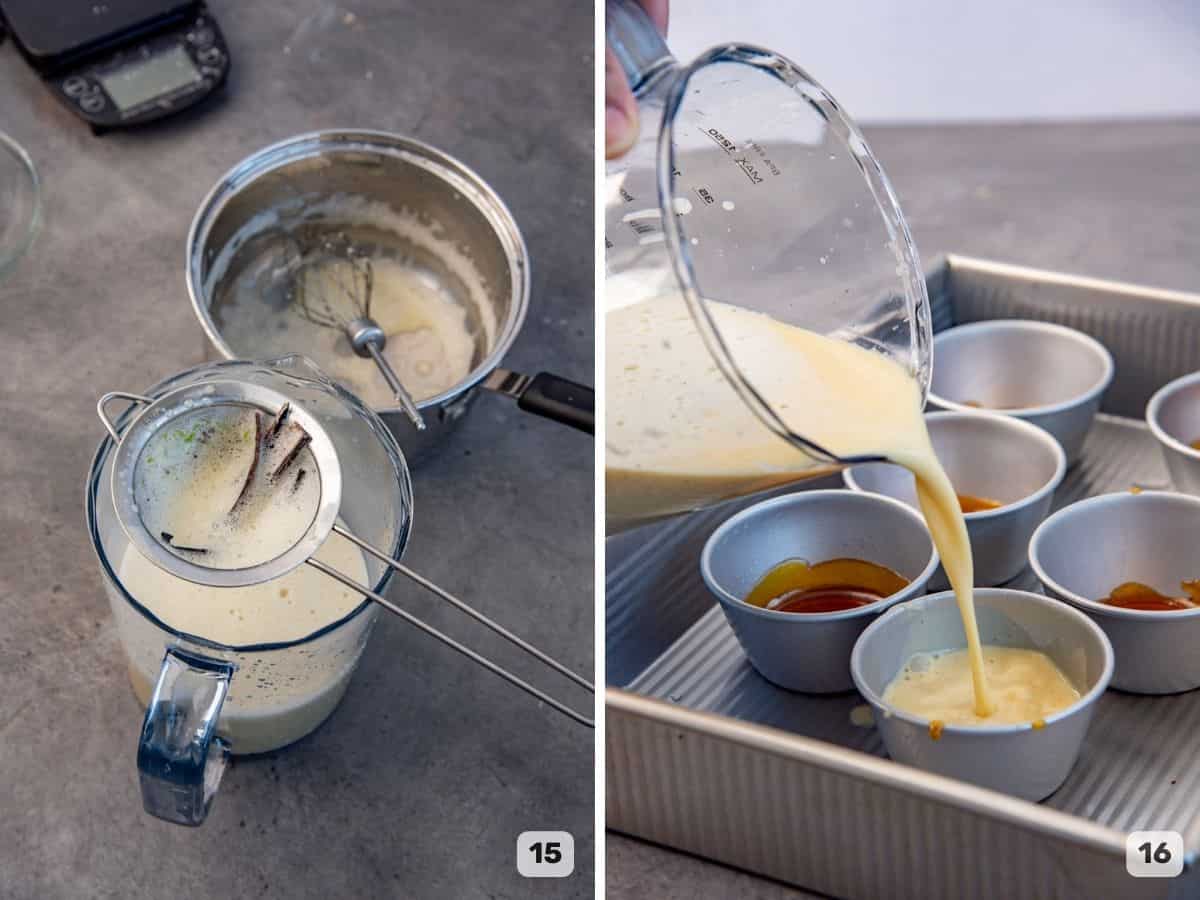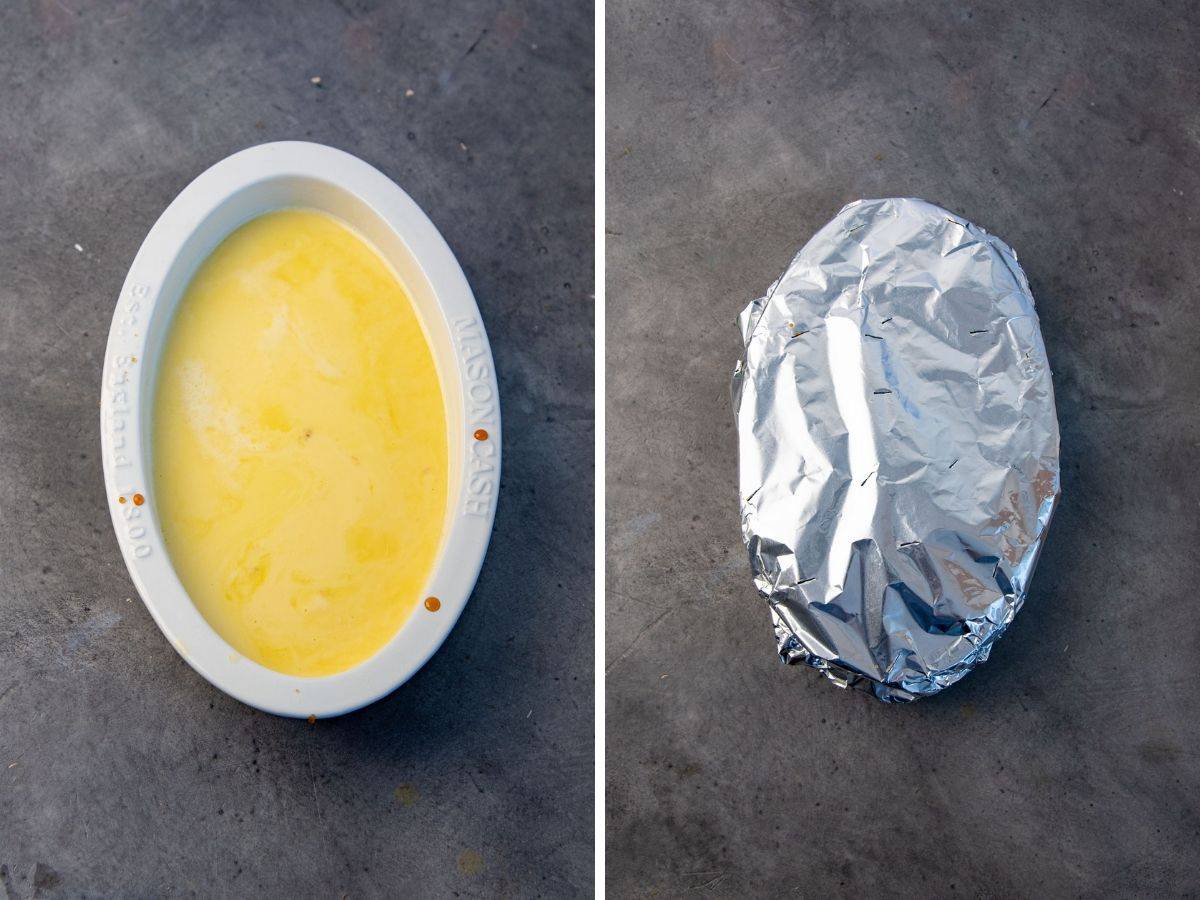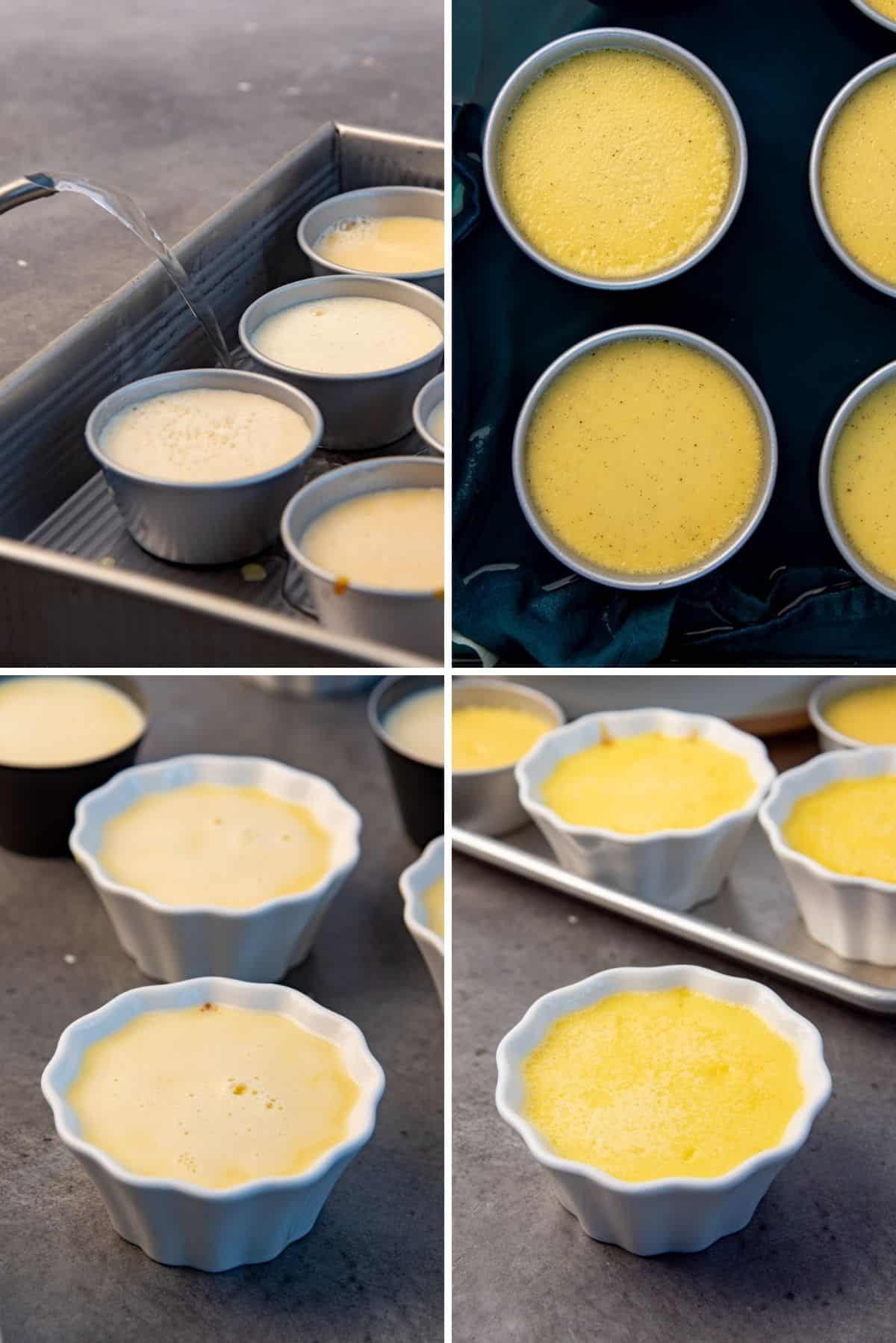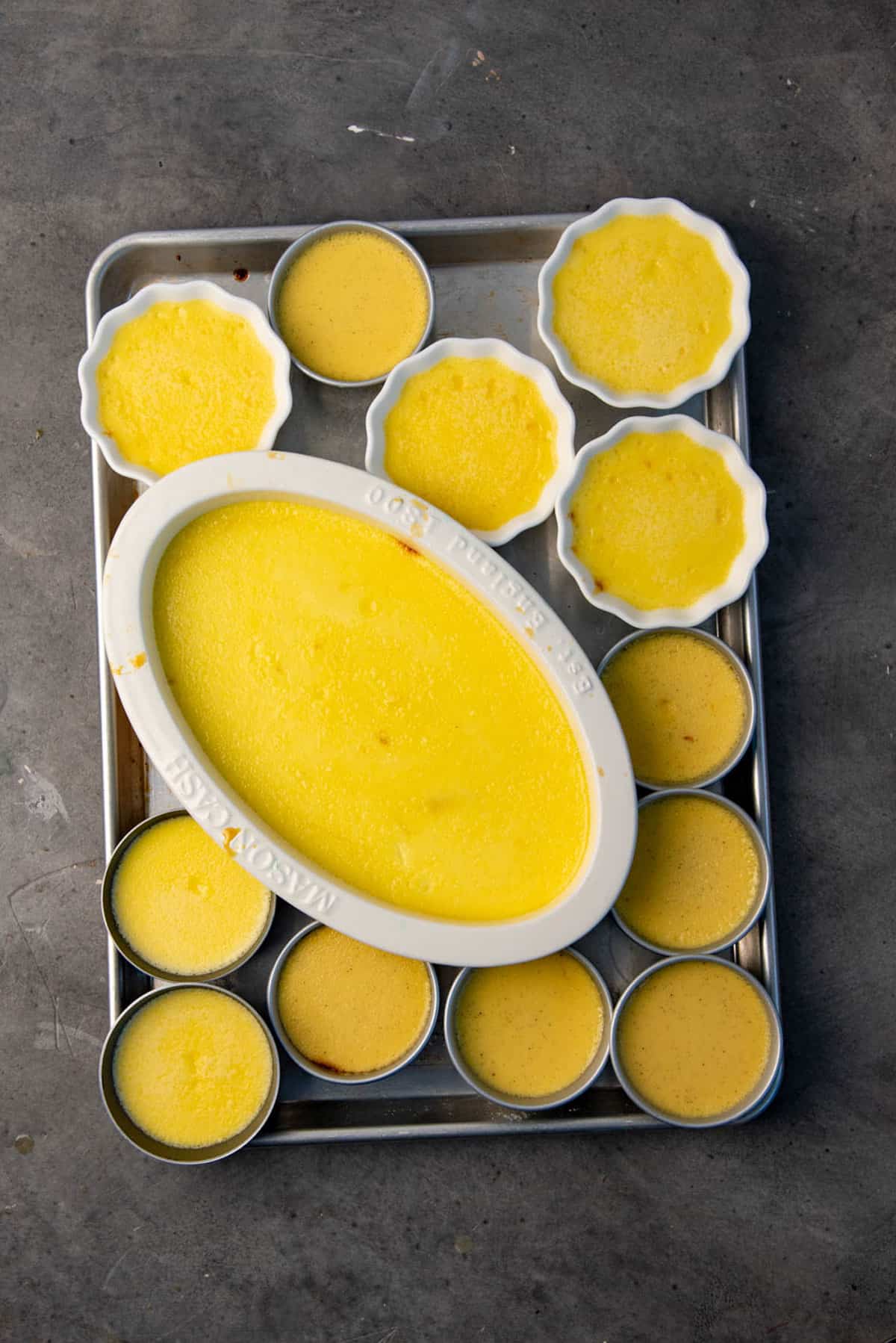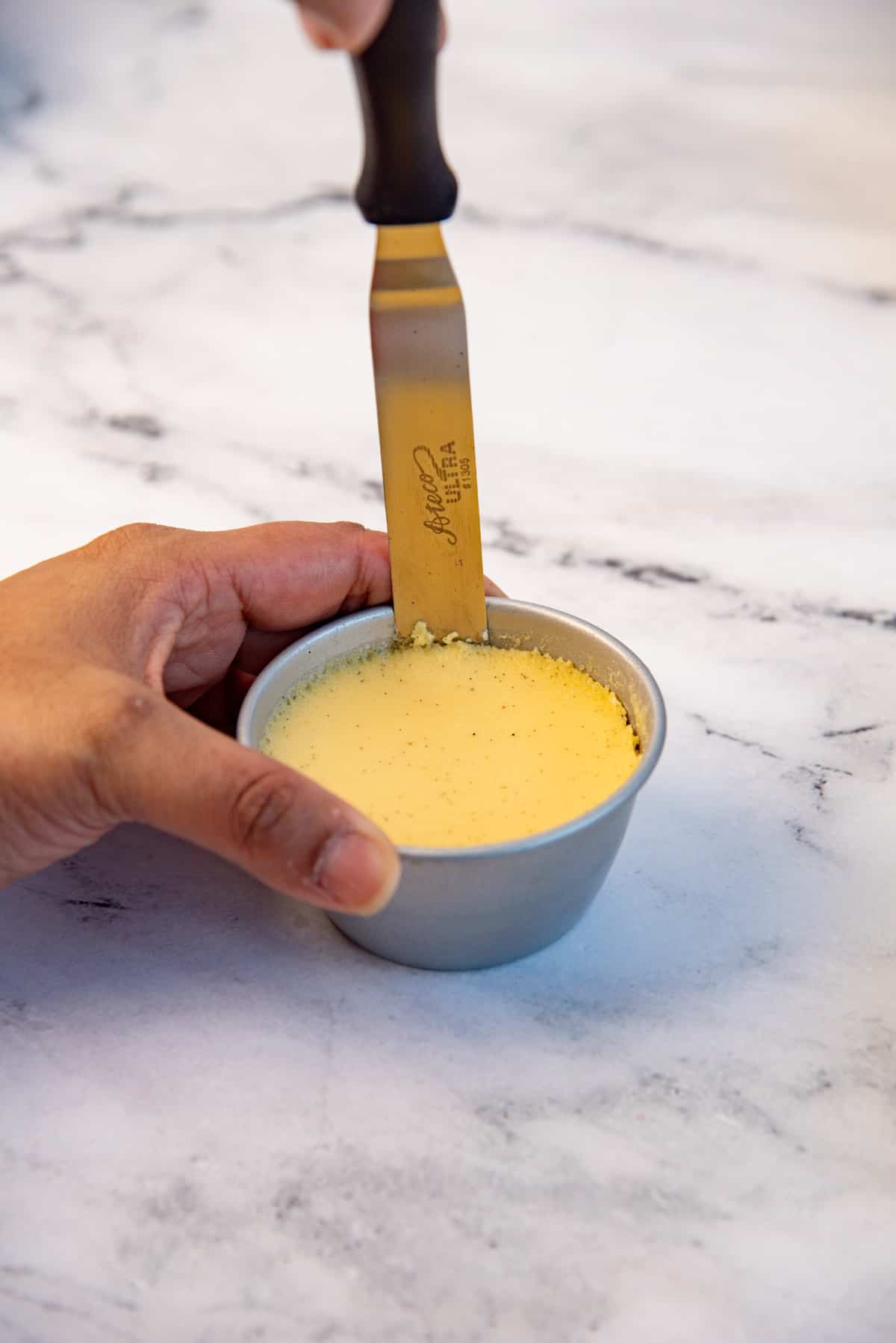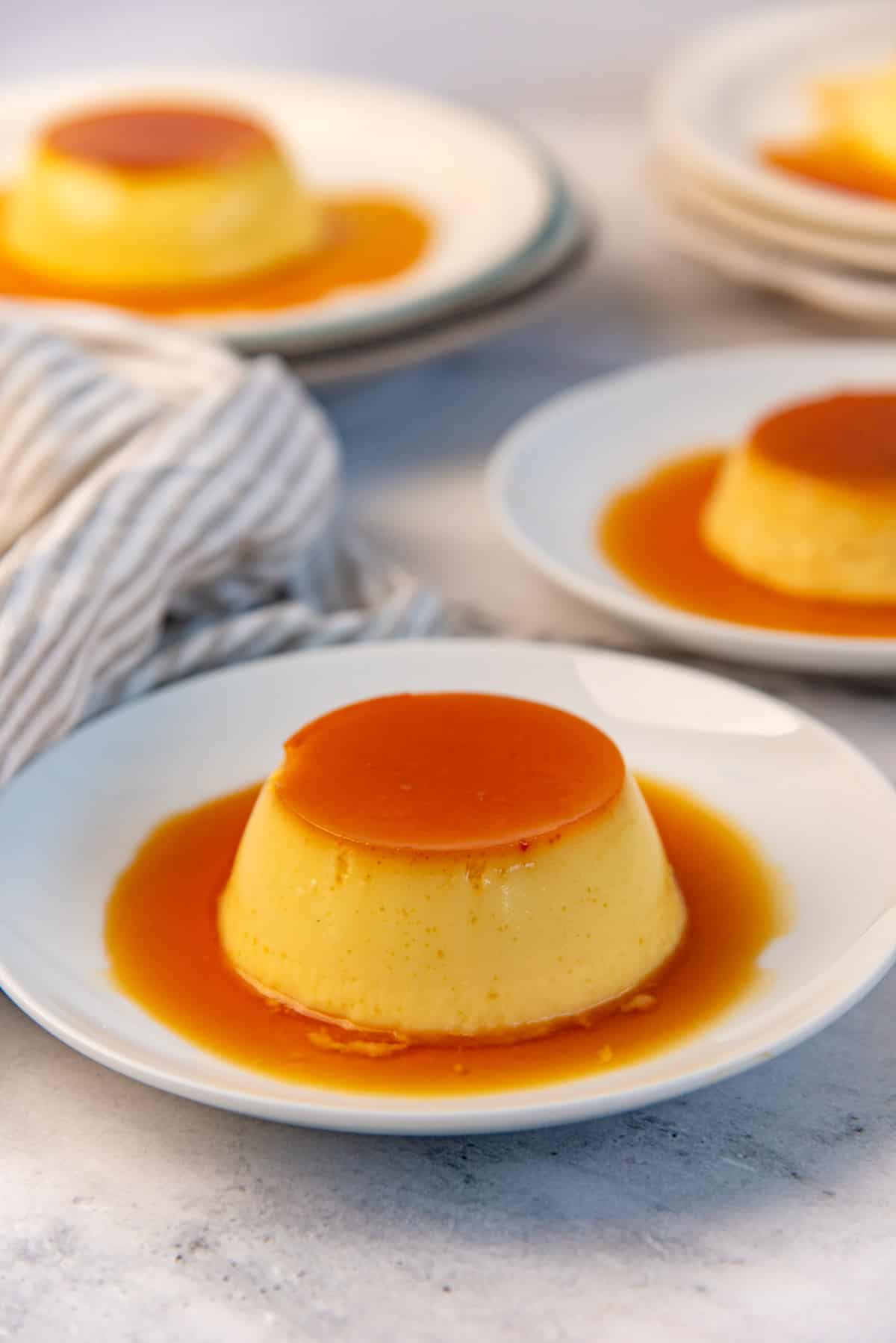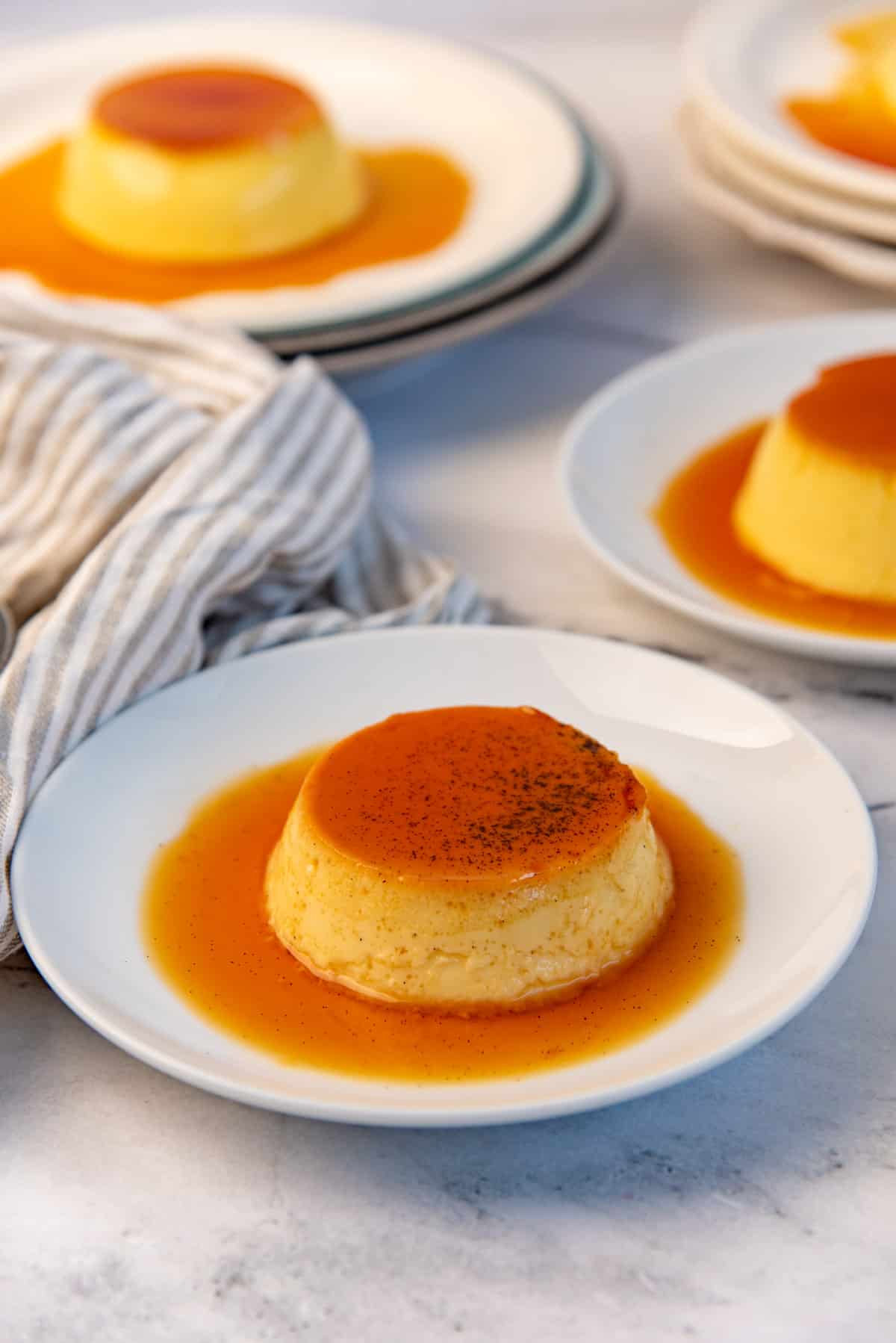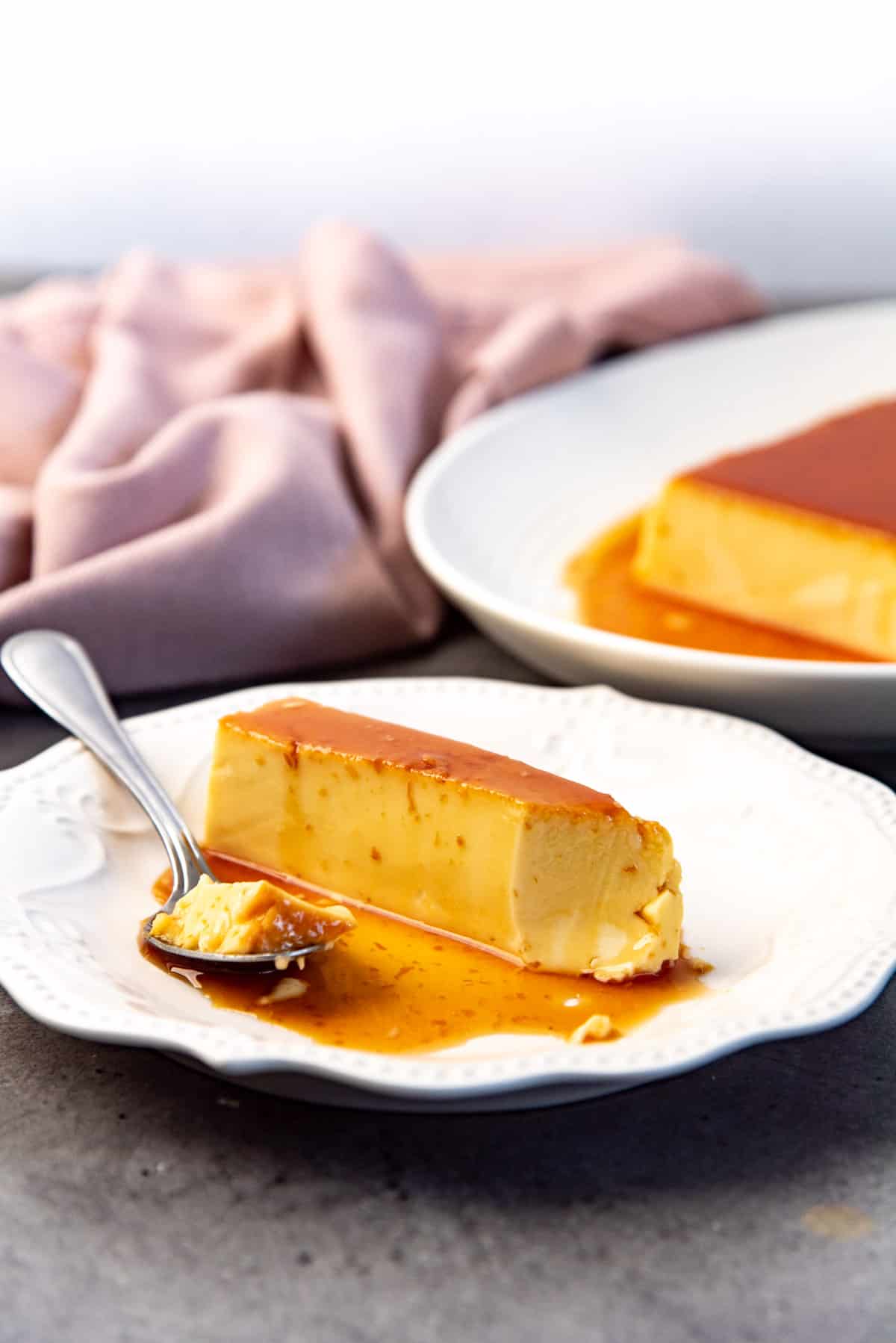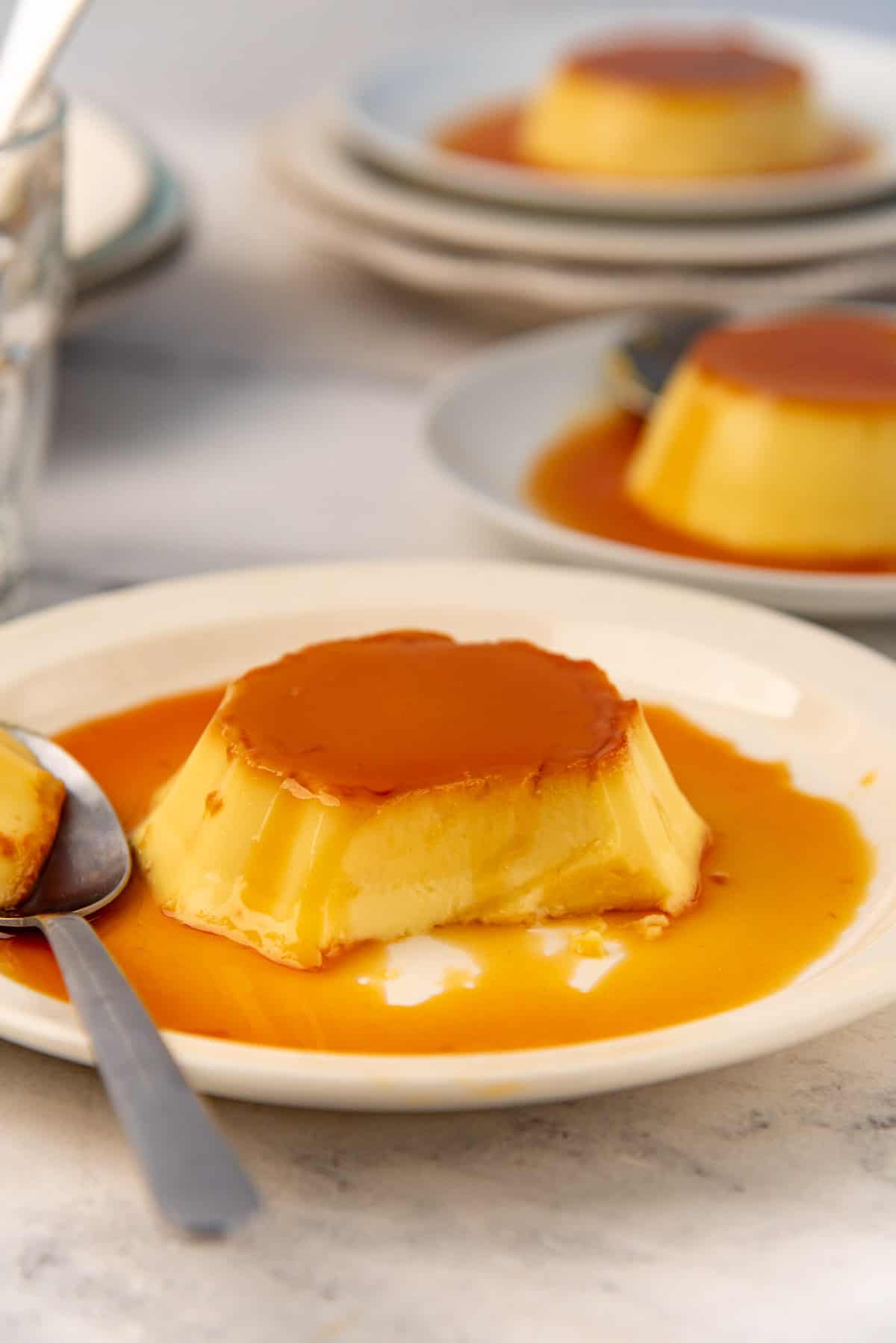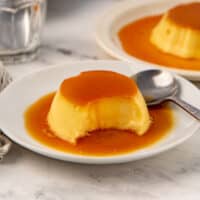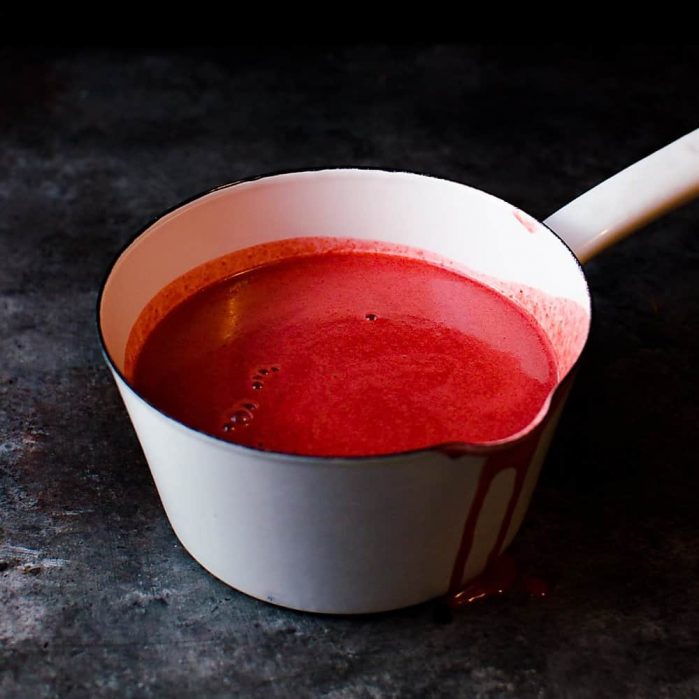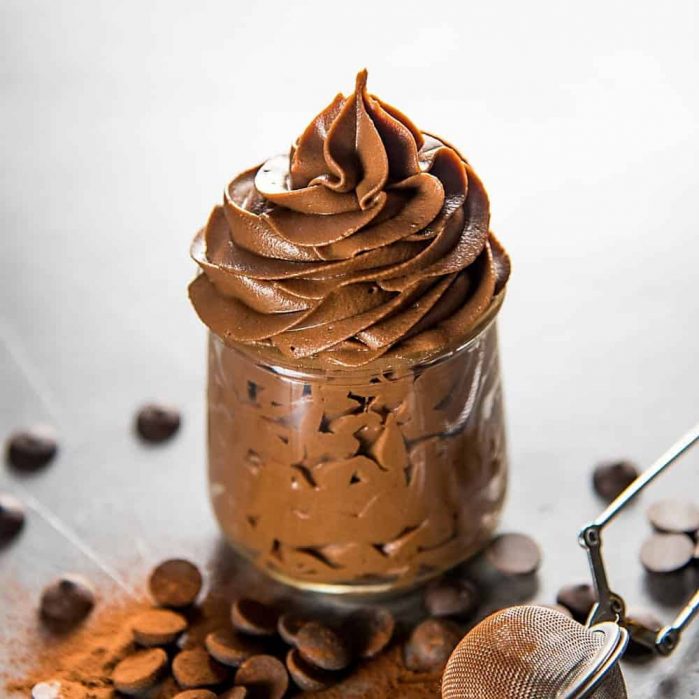Perfectly sweet, milky, creamy custard with a velvety texture, and a lovely caramel flavor with just a hint of caramel bitterness. This perfect crème caramel is a simple yet impressive dessert recipe, great for parties, gatherings, and potlucks!
Why you’ll love this recipe
This is such an easy recipe to follow, even for beginner bakers! Step by step instructions for perfect results, so you know what to look out for at each step. I include different baking times for a few different baking dishes, but also provide tips on how to get the perfect texture with any dish! Pro tips for getting perfect results that look and taste incredible, plus tips on how to improve the flavor further. I share the recipe for making rich crème caramel that is popular in Parisian restaurants (Crème caramel à la Parisienne), but also share a version you can easily make with whole eggs so you don’t have to worry about any leftover egg whites!
What is crème caramel?
“Crème” in this context means custard. And caramel is the caramelized sugar. So, this is a creamy refreshing baked custard, topped with a layer or deeply caramelized sugar. While this crème caramel recipe originates from France (it’s one of the more popular classic French desserts), it’s also very common in many other parts of the world. It is a baked custard based French dessert. Creme caramel is made in ramekins (small or large), with a layer of caramel in the bottom, with custard baked on top. The dessert is then inverted onto plates, so that the custard is presented with a beautiful amber colored caramel flavored top and caramel flavored “syrup. A cousin to creme caramel, classic Crème brûlée is a baked custard dessert, baked in a slightly shallower ramekin. The custard is much richer, as it is made with cream, rather than milk, and has a softer texture. Just before serving, a thin layer of sugar is spread on top and caramelized using a blow torch. The result is a hard caramelized sugar topping that needs to be cracked to eat the creme brulee. Two other desserts that have a similar custard base are bavarian cream (crème bavaroise) and classic panna cotta. Although classic panna cotta is not technically a custard, or baked. It’s a milk-based set pudding made with milk and/or cream and sugar, and set with gelatin. The texture of panna cotta is very similar to creme caramel, as it is soft and jiggly just like baked creme caramel. Creme caramel is also referred to as “Flan” (pronounced flaan) in some parts of the world. Particularly, in Latin American countries, since this dessert was introduced to the region by the Spanish, i.e. Spanish Flan. The biggest difference between creme caramel and flan however, is in how it’s made and which country introduced the dessert to the region.
What’s in a name?
A Classic Creme Caramel is a baked custard made with whole milk, sugar, and whole eggs. However, Creme Caramel à la Parisienne is a cream caramel version that is richer in flavor, made with milk (and optionally cream), sugar, eggs, and egg yolks. In countries where this dessert was introduced by the Spanish, it’s known as flan. This includes, Latin American countries such as Argentina, Columbia, Brazil. It also includes Mexico, and some Asian countries such as the Philippines, Vietnam and Thailand. While flan can be be made with milk as well, it is also made with condensed milk, evaporated milk, and even soft cheeses like cream cheese. Filipino flan also includes ONLY egg yolks and has a slightly different texture for this reason.
Crème caramel ingredients
Milk and cream
Classic creme caramel is made with whole fat milk. However, you can substitute half of the milk with heavy cream. Creme caramel made with all milk has a cleaner texture and flavor. However, if you add cream to the mixture, it transforms the creme caramel with a richer, creamier flavor and texture.
Sugar
You can find sugar at two different stages in a creme caramel. White sugar is the recommended sweetener to use in a classic crème caramel recipe. It’s easier to caramelize (to see the stages clearly), and adds no extra flavor to the custard. However, you can choose to use brown sugar instead as well. I find that the ideal amount of sugar for this custard is between 15 – 20% sugar to the amount of milk. I have not used sugar substitutes in this recipe, especially for the caramelization part. So I cannot recommend a good sugar-free substitute unfortunately.
Eggs
Eggs are what help the custard to set as it bakes. Some recipes call for whole eggs, but I prefer to use a combination of whole eggs and egg yolks. The purpose of adding egg yolks to the creme caramel is to increase the rich taste of the custard as well. The combination of whole eggs and egg yolks provides enough thickening power to set the caramel, while also adding the maximum amount of flavor and richness. However, you can also easily make creme caramel with whole eggs only. The ratio for this is 2 large eggs per 1 cup of milk (about 240 – 250 mL).
Vanilla
Vanilla is the flavoring extract that you add to the caramel base. A flavor extract is absolutely essential for creme caramel, and vanilla is the most commonly used flavor extract. Vanilla extract, whole vanilla beans, or even vanilla bean paste is acceptable for this recipe. However, you can absolutely switch this out for other flavor extracts as well.
Orange blossom water (which was used in very old recipes for custard when vanilla wasn’t widely available). Rose water Citrus extracts Almond extract
Salt
Just a touch of salt prevents the creme caramel from tasting bland. But in this case, you only need to add a little because you don’t want the salty flavor to overpower the sweetness at all.
Optional ingredients
These are optional ingredients that I personally love to add to my crème caramel recipe. Spices – Cinnamon stick, cardamom pods etc. Adding whole spices to the milk will add just a lovely undertone of these spices to the custard. It’s not necessary or required for a classic caramel, but I love the added flavor dimension in my creme caramel recipe. Citrus zest – If not spices, I add some lemon zest, or orange zest, or lime zest. Whichever citrus fruit I have available at home. This step achieves two things. It adds a lovely citrus undertone to the creme caramel, without it being sour or overly citrussy. It also helps reduce any “eggy” smell that some people might be more sensitive to.
How to make crème caramel with step by step instructions
Step 1 – Prepare the milk
Decide if you’re making one large crème caramel pudding or small individual-sized puddings. Then clean and dry the dish or dishes you will be using. Older recipes for cream caramel may call for scalding the milk. Technically, this is not necessary anymore. However, I do like to heat the milk anyway. Place the milk in a small saucepan (along with the cream, if using). If you’re using vanilla beans, split the bean and scrape out the caviar using the back of a knife blade (Image 1 – 3). I also like to add any citrus zest or spices at this stage, so the milk has time to infuse with the flavors. But this does not have an impact on desserts such as creme caramel. So we don’t have to scald the milk at all. But I do still recommend heating the milk to a simmer or until it steams. This helps with infusing flavors, and also to shorten the cooking time. Then add the caviar and the pod to the milk and let it heat to a gentle simmer (Image 4). If you don’t need to infuse any flavors into the milk, you can make the caramel first. When the milk mixture comes to a simmer or is steaming well, remove it from the heat and let it infuse for a few minutes. The milk should be around 160 F / 71 C or lower before adding it to the eggs.
Step 2 – Prepare the the baking dishes
While the milk is infusing, the next step is to make the caramel for the bottom of the dishes. This caramel can be made as a wet caramel or a dry caramel. Whichever is easier for you. Also heat the oven to 350 F / 180 C, and also take a large baking tray to use as a water bath. The water bath should be big enough to comfortably accommodate all the baking dishes with the creme caramel, with at least an inch of space between them. Place a kitchen towel on the bottom of the water bath dish. This will prevent the dishes from slipping around. You will also need to use hot water to add to the dish.
Step 3 – Make the caramel
I personally prefer the dry caramel method because there is less of a risk of recrystallization. To make the caramel, place the sugar in a wide pan where the sugar will be in a thinner layer. A wider bottom will ensure that the sugar dissolves quicker and caramelizes easily, but make sure you can see the color of the caramel (i.e. not dark colored pans). Heat the sugar over medium high heat. When the sugar at the bottom of the pan starts to melt (Image 5), move it aside with a spatula so that the rest of the sugar can make contact with the bottom of the pan and start to melt (Image 6). The sugar will melt and start to change to a light yellow color. Mixing the caramel will make it a little lumpy too (Image 7). This is OK! At this stage, if the lumps are big, remove the pan from the heat while the caramel is a light yellow color, and stir the mixture to break the clumps and melt them. Then return the caramel back to the stove. Lower the heat to medium or medium low to caramelize the sugar a little slower, as this will happen quite quickly. As soon as the caramel turns an amber color (Image 8), remove it from the heat. You can use the caramel while it’s an amber color, or let it darken a little more for a slightly bitter caramel. Pour the caramel carefully into the baking dishes (Image 9). There needs to be a minimum of a thin coating of caramel at the bottom of the baking dish, BUT I like to add a little more than a thin coating, roughly about 5 mm thickness (it’s hard to measure this, so just eye-ball it). Caramel is VERY HOT, so you could burn yourself if it gets on your skin! Please handle the caramel carefully. The caramel will heat the metal cups you put the caramel into as well, so handle carefully. Set the dishes aside, while you make the custard. Alternatively, you can also brush the sides of the ramekins with a little butter to make it easier to release the custards later – but this is not necessary (Image 10).
Step 3 – Tempering the eggs
With this recipe, I do prefer to use a combination of whole eggs and egg yolks, but I also share how to make creme caramel with only whole eggs! This will result in a thinner, more jello-like consistency that still tastes delicious! In a large jug or bowl, place the eggs and egg yolks along with the white sugar (Image 11). Whisk very well. The egg mixture should not have any clumps of eggs, and be slightly frothy (Image 12). If you’re using egg yolks, make sure to store the egg whites in the freezer, so you can use them for another recipe later. While still whisking the egg mixture, add the hot milk in a thin stream. It’s very important to keep mixing the eggs while adding the warm milk, slowly, to prevent the eggs from curdling. This is called “tempering the eggs”, because the egg temperature is being tempered to match the temperature of the milk(Image 13). Once the egg mixture has been warmed up with the milk, add all the milk into the eggs and mix to combine Image 14). Then strain the mixture to remove any lumps or spices that were used to infuse the milk (Image 15).
Step 4 – Preparing for baking
Pour the custard mixture into the dish or dishes with the caramel at the bottom (Image 16). Then place all of them in the bigger baking dish that will be used as a water bath. Since there is a dish cloth at the bottom of the water bath, the creme caramel dishes should not slip or move around. Place this in the preheated oven, and carefully pour hot water into the water bath dish. Be careful not to splash water into the custards. Then cover the dish with foil, with some holes for ventilation. Allow the creme caramel to bake.
Step 5 – Baking the custards
Bake the custards until the custards are set, but wobbly. The time it takes to bake will vary on a number of variables.
The dish that you use – Metal vs porcelain. Metal cooks the custard faster than porcelain. The size of the dish – Smaller dishes will cook faster than larger baking dishes. How thick the custard will be in the dish will also have an impact on the baking time. Starting temperature of the custard – If the custard is warm, the baking time will shorten. If the custard is at room temperature or cooler, it will take longer.
The best and foolproof way to know when the custard is baked through is to check the texture, Once the custard is baked, remove it from the oven and the water bath. Let it cool to room temperature and then transfer to the fridge to chill overnight.
Step 5 – Serve
Before serving the creme caramel, it must be turned out onto a dish. To do this, release the edges of the custard in the baking dish. You can use a thin blade, or clean fingers to slightly push down the edges to “break the seal”. Then warm up the dish by placing it in a bowl of really hot water for a few seconds. You can alternatively use a blow torch too. Turn the dish over onto a small plate or your serving platter. Then while holding the serving dish AND the over-turned baking dish in your hands, firmly shake the two dishes together in a downward motion a few times. You will hear a “plop” sound when the custard releases. Carefully remove the baking dish. The caramel-topped custard should be ready to serve now on your serving platter!
Recipe tips and how to elevate the flavor
Let’s talk about how to make sure you get the best creme caramel dessert. These tips also apply if you’re making flan.
Make sure the caramel layer is smooth inside the baking dish. Since the caramel cools and hardens quickly, it’s very important that you don’t try to move the caramel around while its hardening. Bumps and uneven caramel layers will cause dips and cracks on top of the creme caramel. Use a few strips of lemon or orange peel in the milk. This will help eliminate any eggy smells even further and add a lovely flavor that isn’t overpowering at all. Let the caramel caramelize! Most of the time, the caramel is only cooked until it’s a golden brown. However, the creme caramel tastes better when the caramel is cooked until it’s amber in color. The slight bitterness from the caramel really makes the pudding taste even better. Cook in a water bath. This will help cook the custard more evenly and prevent overcooking. Let the creme caramel chill overnight. This will make the custard taste even better. If you’re afraid of the custard getting stuck to the dish, lightly butter the sides of the dish before adding the custard. Use heat (hot water or blow torch) to loosen up the caramel custard. For a richer, creamier texture and flavor, use half heavy cream and egg yolks. For a cleaner, more jello-like texture, use milk and whole eggs.
Variations
Add instant coffee to the milk mixture to make coffee creme caramel! I love this variation because coffee and caramel pair so well together. Instead of just plain caramel, you can add thinly sliced caramelized apple to the bottom of the dishes. This will impart a lovely apple flavor to the creme caramel too (like this poached apple and cinnamon creme caramel). Instead of white sugar, you can use brown sugar. This version will have a rich molassy flavor thanks to the brown sugar. For a dairy free creme caramel, use coconut milk instead of regular milk. To make this even more flavorful, substitute the sugar with muscavado sugar, and add some cardamom to the custard too. This is the base for the very popular Sri Lankan custard dessert – Watalappan. Add cinnamon for a Mexican flan version made with milk instead of condensed milk. Substitute the sugar with dulce de leche for even more flavor.
Serving suggestions
Creamy crème caramel covered in liquid caramel is such a perfect dessert, it does not need to be served with anything else, really! However, regional variations may serve cream caramel differently.
Whipped cream will be a lovely addition for creme caramel. In some South American regions, it is served with dulce de leche. In Cuba, creme caramel (or in this case, Flan) is served with ice cream (like a delicious homemade vanilla ice cream). Creme caramel in some regions of France is made with a splash of apple brandy, and in the French region Brittany, it’s made with salted butter which adds a buttery, sweet, salty flavor! In Vietnam, creme caramel is added to an iced coffee drink, where coffee is poured over the creme caramel and served with ice. In South Asia, creme caramel is served with a cup of tea! In India, this would be masala chai, and in Sri Lanka, it would be a classic Ceylon tea.
Storage instructions
This dessert can be made and stored in the fridge for about 4 – 5 days. Make sure to keep it covered with plastic wrap, or in an airtight container. If you have leftovers, then cover the dish with plastic wrap or place the leftover pudding in an airtight container. Freezing and thawing creme caramel may change the creamy texture of the pudding, so I don’t recommend doing this.
Frequently asked questions

